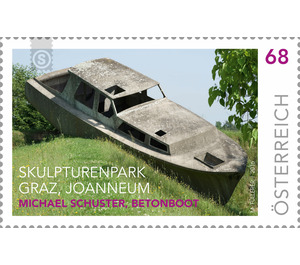art - Austria / II. Republic of Austria 2016 - 68 Euro Cent
Theme: Art & Culture
| Country | Austria / II. Republic of Austria |
| Issue Date | 2016 |
| Face Value | 68.00 |
| Edition Issued | 250,000 |
| Printing Type | offset |
| Stamp Type | Commemorative |
| Item Type | Stamp |
| Chronological Issue Number | 2612 |
| Chronological Chapter | OOS-OE2 |
| SID | 379528 |
| In 75 Wishlists | |
The sculpture park in Styrian Unterpremstätten, seven kilometers south of Graz, was originally built on the initiative of former ORF director Emil Breisach, who began in 1981 to exhibit plastic works by Austrian artists on the Graz ORF site. The aim was to make contemporary sculptures outside a museum accessible to the public. In 2000, the International Garden Show, designed by Swiss landscape architect Dieter Kienast, took place in Unterpremstätten - and the area turned out to be ideal for use as a sculpture park. The Privatstiftung Österreichischer Skulpturenpark was founded and presented the concept of an international sculpture park, developed by Christa Steinle and formulated by Peter Weibel, in 2003 to the public. Four years later, the operation of the sculpture park was handed over to the Landesmuseum Joanneum. Since then, the collection of works by Austrian as well as international artists has been constantly expanded, accompanied by a scientific discourse. Today, the park comprises more than 70 sculptures on an area of about seven hectares, including Austrians such as Fritz Wotruba, Franz West, Erwin Wurm, Heimo Zobernig and Michael Kienzer, but also international artists such as Nancy Rubins or Yoko Ono. The concrete boat of the Graz artist Michael Schuster reflects his surroundings in an objective form. The boat seems to have been thrown out of the nearby lake and now lies in the waves of the artificial hilly landscape, making it part of the artistic work. The sculptural representation of a real object, the boat, through a concrete casting alludes to the function of the park as a sculptural space; At the same time, the "stranded" artwork can also be understood as an ironic allusion to the subject of sculpture park. - Michael Schuster, born in Graz in 1956, has been dealing with the problems of perception and the reproduction of reality in his media-reflective works such as photo installations, light objects and medial sculptures since the 1970s.


